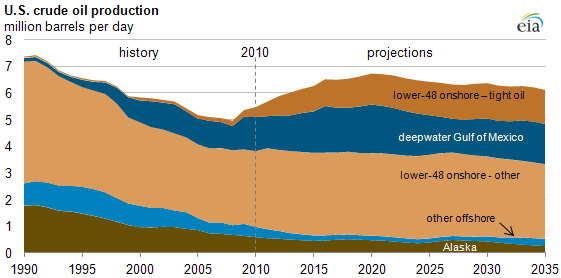
Tight oil, Gulf of Mexico deepwater drive projected increases in U.S. crude oil production

Notes: Crude oil includes lease condensate. Tight oil projections are for selected tight oil plays. Data from the AEO2012 Early Release Reference case are subject to change with the release of the full AEO in spring 2012.
Download CSV Data
EIA's Annual Energy Outlook 2012 (AEO2012) Early Release Reference case, providing updated projections for energy markets through 2035, projects increased domestic crude oil production driven by development of tight oil resources onshore and deepwater resources in the Gulf of Mexico. Tight oil refers to oil produced from shale, or other very low-permeability rocks, with horizontal drilling and multi-stage hydraulic fracturing technologies.
EIA projects that U.S. domestic crude oil production will increase from 5.5 million barrels per day in 2010 to 6.7 million barrels per day in 2020. Even with a projected decline after 2020, U.S. crude oil production projections remain above 6 million barrels per day through 2035.
The AEO2012 Early Release Reference case projects that onshore tight oil production will increase significantly, reaching 1.3 million barrels per day in 2030 and remaining above 1 million barrels per day for the remainder of the projection. As with shale gas, the application of recent technology advances significantly increases the development of tight oil resources. Projections are made for selected tight oil plays; at this point, not all plays have been, or are being, evaluated for the application of emerging production technology.
The AEO2012 also projects that continued development of deepwater crude oil resources in the Gulf of Mexico will become an increasingly important component of domestic crude production. Drilling in the Gulf of Mexico Outer Continental Shelf has resumed following the lifting of the 2010 moratorium, but on a schedule moderated by a slower permitting process with increased environmental review. Production in the Gulf of Mexico fluctuates as new large development projects are brought onstream.
The AEO2012 Early Release Reference case assumes that lease options in the Pacific and Atlantic will eventually be opened, but significant production from those lease sales is projected to occur after 2035. Most of the Eastern Gulf of Mexico Planning Area remains under a Congressional drilling moratorium (the Gulf of Mexico Energy Security Act of 2006) until 2022.